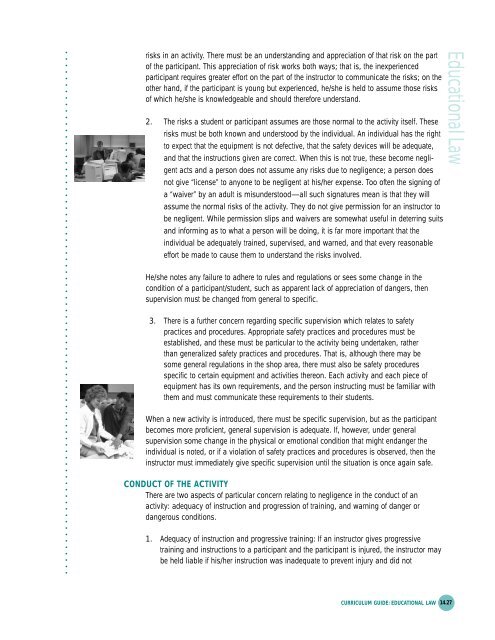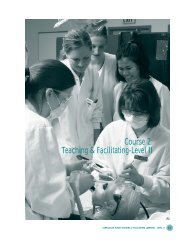Educational
Educational Law - Washington State Center of Excellence for ...
Educational Law - Washington State Center of Excellence for ...
- No tags were found...
Create successful ePaper yourself
Turn your PDF publications into a flip-book with our unique Google optimized e-Paper software.
○ ○ ○ ○ ○ ○ ○ ○ ○ ○ ○ ○ ○ ○ ○ ○ ○ ○ ○ ○ ○ ○ ○ ○ ○ ○ ○ ○ ○ ○ ○ ○ ○ ○ ○ ○ ○ ○ ○ ○ ○ ○ ○ ○ ○ ○ ○ ○ ○ ○ ○ ○ ○ ○ ○ ○ ○ ○ ○ ○ ○ ○ ○ ○ ○ ○ ○ ○ ○ ○ ○ ○ ○ ○ ○ ○ ○ ○ ○ ○ ○ ○<strong>Educational</strong> Lawrisks in an activity. There must be an understanding and appreciation of that risk on the partof the participant. This appreciation of risk works both ways; that is, the inexperiencedparticipant requires greater effort on the part of the instructor to communicate the risks; on theother hand, if the participant is young but experienced, he/she is held to assume those risksof which he/she is knowledgeable and should therefore understand.2. The risks a student or participant assumes are those normal to the activity itself. Theserisks must be both known and understood by the individual. An individual has the rightto expect that the equipment is not defective, that the safety devices will be adequate,and that the instructions given are correct. When this is not true, these become negligentacts and a person does not assume any risks due to negligence; a person doesnot give “license” to anyone to be negligent at his/her expense. Too often the signing ofa “waiver” by an adult is misunderstood—all such signatures mean is that they willassume the normal risks of the activity. They do not give permission for an instructor tobe negligent. While permission slips and waivers are somewhat useful in deterring suitsand informing as to what a person will be doing, it is far more important that theindividual be adequately trained, supervised, and warned, and that every reasonableeffort be made to cause them to understand the risks involved.He/she notes any failure to adhere to rules and regulations or sees some change in thecondition of a participant/student, such as apparent lack of appreciation of dangers, thensupervision must be changed from general to specific.3. There is a further concern regarding specific supervision which relates to safetypractices and procedures. Appropriate safety practices and procedures must beestablished, and these must be particular to the activity being undertaken, ratherthan generalized safety practices and procedures. That is, although there may besome general regulations in the shop area, there must also be safety proceduresspecific to certain equipment and activities thereon. Each activity and each piece ofequipment has its own requirements, and the person instructing must be familiar withthem and must communicate these requirements to their students.When a new activity is introduced, there must be specific supervision, but as the participantbecomes more proficient, general supervision is adequate. If, however, under generalsupervision some change in the physical or emotional condition that might endanger theindividual is noted, or if a violation of safety practices and procedures is observed, then theinstructor must immediately give specific supervision until the situation is once again safe.CONDUCT OF THE ACTIVITYThere are two aspects of particular concern relating to negligence in the conduct of anactivity: adequacy of instruction and progression of training, and warning of danger ordangerous conditions.1. Adequacy of instruction and progressive training: If an instructor gives progressivetraining and instructions to a participant and the participant is injured, the instructor maybe held liable if his/her instruction was inadequate to prevent injury and did notCURRICULUM GUIDE: EDUCATIONAL LAW 14.27




